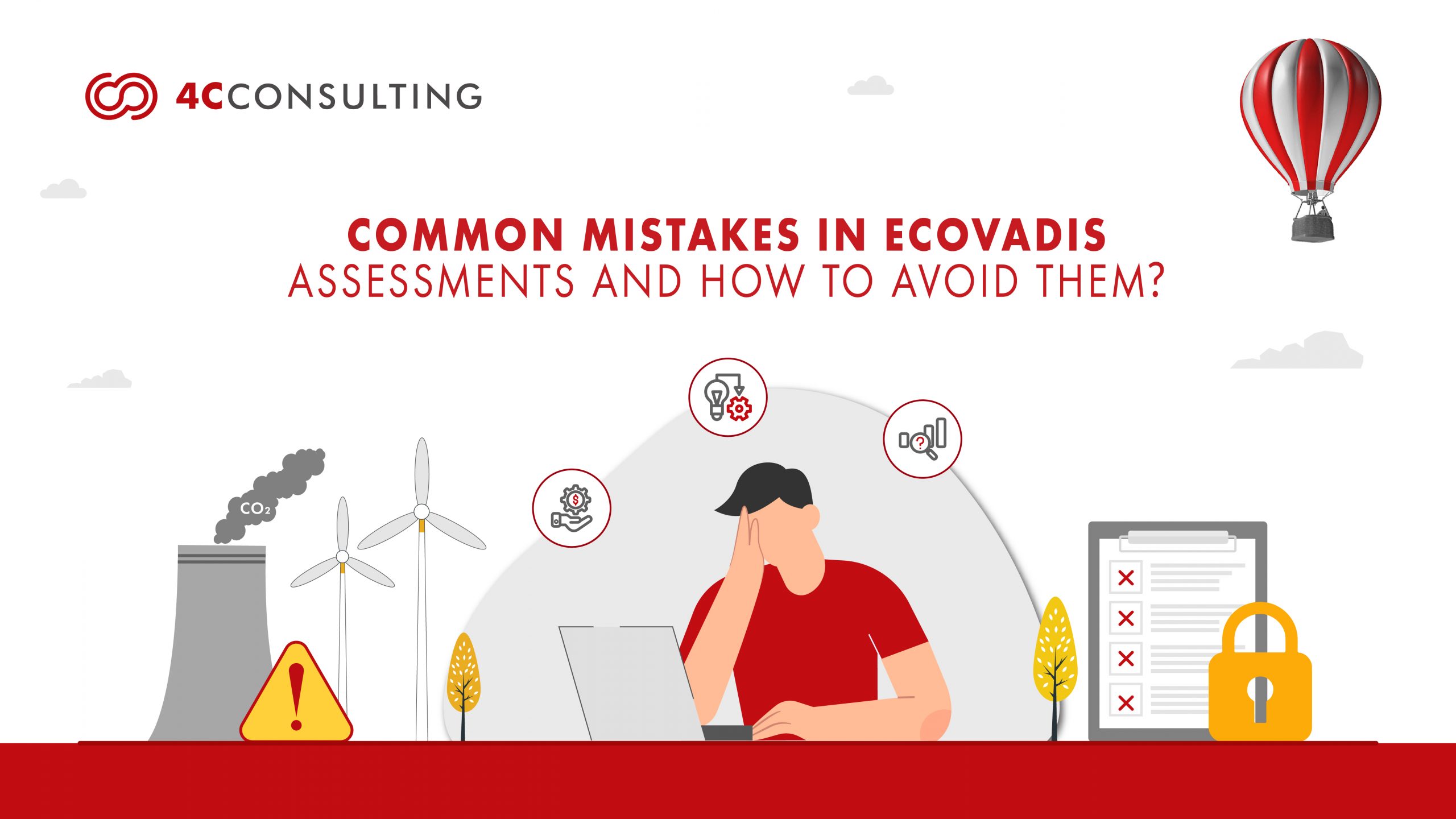
Common Mistakes in EcoVadis Assessments and How to Avoid Them
31st Oct, 2025
Did you know that a large proportion of companies underperform in their first EcoVadis sustainability assessment due to inconsistent ESG documentation and weak implementation evidence? EcoVadis data trends show that organizations without structured sustainability governance frameworks or supplier evaluation systems often face lower EcoVadis scores during their initial submission. These gaps lead to repeated revisions, delayed assessment cycles and missed qualification opportunities with global buyers.
The EcoVadis assessment is not a procedure it is a data-driven evaluation that measures how effectively sustainability principles are integrated into business strategy, operational controls and supply chain management. A single missing KPI, outdated policy or weak supplier risk mechanism can impact an organization’s overall rating.
This blog addresses the 10 most common mistakes companies make during EcoVadis assessments and provides targeted solutions to help organizations strengthen ESG reporting, improve evidence credibility and achieve higher performance scores in future evaluations.
EcoVadis Assessment for Sustainable Business Performance
The EcoVadis sustainability assessment serves as a globally recognized framework for evaluating corporate sustainability and ethical business conduct. It measures an organization’s performance across four central pillars Environment, Labor & Human Rights, Ethics and Sustainable Procurement. Each company receives a detailed scorecard ranging from 0 to 100, reflecting its ESG maturity, along with medals (Bronze, Silver, Gold or Platinum) that signify performance levels. These independent ratings are widely used by global buyers and partners to benchmark supplier responsibility and operational transparency.
How the EcoVadis Assessment Works?
The process begins with a comprehensive self-assessment, where organizations provide structured data and documentation related to their sustainability policies, systems and results. This submission is then reviewed by EcoVadis analysts, who verify the evidence through a standardized evaluation methodology. The outcome is a quantitative scorecard highlighting performance strengths, improvement priorities and industry-based rankings. Companies that demonstrate consistent improvement and strong sustainability integration are awarded medals recognized by clients and stakeholders.
What the Assessment Evaluates and Why It Matters?
The EcoVadis assessment evaluates performance across four major domains:
- Environmental Impact: energy use, emissions, waste management and climate action initiatives.
- Labor and Human Rights: fair employment, health and safety, diversity and inclusion practices.
- Ethics: anti-corruption, data protection and responsible business conduct.
- Sustainable Procurement: supplier risk management, sourcing practices and lifecycle responsibility.
By translating qualitative ESG performance into measurable outcomes, EcoVadis enables organizations to benchmark themselves against global standards, identify operational gaps and enhance sustainability maturity. For leadership teams, the assessment serves as both a strategic measurement tool and a communication platform, allowing them to demonstrate responsible business practices through verified, globally comparable data.
10 Common Mistakes in EcoVadis Assessments and How to Avoid Them.
- Treating the EcoVadis Assessment as a Documentation Exercise: Many organizations approach the EcoVadis assessment as a documentation upload rather than a structured sustainability performance evaluation. The EcoVadis methodology reviews how effectively a company translates Policies, Actions, Results, Recognition across its management system. Uploading isolated policies without evidence of implementation, monitoring, or outcomes lowers maturity across all themes.
How to Avoid It: Present evidence as a traceable chain of performance. For every uploaded policy, include KPIs, internal audits, or management-review minutes. Demonstrating policy-to-action linkage shows that ESG is operationally managed and directly improves the EcoVadis scorecard.
- Submitting Outdated or Incomplete Evidence: Expired certificates, partial datasets, or outdated sustainability reports frequently reduce the EcoVadis rating. Evidence older than 18 months fails to meet validation criteria and weakens confidence in the Actions and Results dimensions. Incomplete uploads disrupt the integrity of the EcoVadis evaluation process and delay scoring.
How to Avoid It: Establish an evidence-management calendar synchronized with annual ESG reporting. Verify that environmental, health & safety, and supplier-assessment data are current and complete. A continuously updated repository reflects sound data governance and strengthens reliability during EcoVadis audit preparation.
- Weak ESG Governance and Undefined Roles: Insufficient ESG governance leads to fragmented accountability and reactive sustainability actions. The EcoVadis sustainability assessment examines management oversight, documented responsibilities, and review mechanisms. Absence of leadership involvement or escalation paths indicates low system maturity and affects scoring under Ethics and Labour & Human Rights.
How to Avoid It: Form an ESG governance committee chaired by senior leadership. Define roles, set meeting frequencies, and maintain minutes with Corrective Action Plan (CAP) tracking. Strong governance documentation reinforces management commitment and elevates the EcoVadis score across all pillars.
- Disorganized Evidence and Poor Mapping: sustainability efforts can lose impact if evidence is scattered or inconsistently labelled. Analysts must trace how policies connect to outcomes; missing context or disordered folders make validation difficult and lower assurance levels.
How to Avoid It: Structure your submission according to the four EcoVadis themes Environment, Labour & Human Rights, Ethics, and Sustainable Procurement. Use standardized filenames, concise document summaries, and an evidence-mapping index. Well-organized submissions demonstrate process control and improve efficiency during the EcoVadis assessment process.
- Insufficient Quantitative Data and KPIs: Many companies weaken their EcoVadis assessment performance by relying on descriptive statements rather than measurable outcomes. The EcoVadis certification framework evaluates progress through quantifiable evidence, weighting performance trends over intent. Missing baselines, targets or year-on-year improvement metrics often result in lower maturity in the Results dimension of the EcoVadis scorecard.
How to Avoid It: Establish clear ESG performance indicators such as GHG emission reductions (tCO₂e/year), energy consumption per production unit, water-use intensity, or gender diversity ratios. Support these KPIs with at least two years of validated trend data and independent verification. Robust quantitative reporting transforms sustainability claims into measurable business value, directly strengthening the organization’s EcoVadis rating.
- Neglecting Supplier Sustainability Evaluation: Strong internal programs alone are insufficient if supplier practices remain unchecked. The EcoVadis assessment for suppliers under the Sustainable Procurement pillar reviews ESG risk screening, supplier codes of conduct, and performance monitoring. Missing supplier audits or SAQs lowers the theme-weighted score.
How to Avoid It: Integrate ESG criteria into procurement. Conduct supplier sustainability evaluations, track CAP closures, and communicate improvement expectations. Documented supplier engagement enhances traceability and boosts Sustainable Procurement performance in the EcoVadis evaluation process.
- Ignoring Feedback from Previous Assessments: Re-submitting identical evidence without addressing improvement points signals non-progress. EcoVadis performance improvement depends on responsiveness to feedback captured in prior scorecards. Failing to act on weak indicators leads to recurring low scores.
How to Avoid It: Use the previous EcoVadis scorecard as a baseline. Analyse theme-level gaps, execute corrective actions, and record tangible improvements. Documenting closure of past findings demonstrates continual improvement a key maturity factor in the EcoVadis assessment process.
- Limited Employee Awareness and Engagement: Sustainability goals cannot succeed without employee understanding and participation. The EcoVadis rating system expects verifiable evidence of workforce engagement under the Actions dimension. Limited awareness leads to procedural compliance rather than cultural integration.
How to Avoid It: Implement structured ESG training, communication campaigns, and department-level initiatives. Keep sign-in sheets, agendas, and evaluation reports as proof. Employee involvement confirms that ESG is integrated throughout operations, improving overall EcoVadis maturity.
- Lack of External Validation or Independent Assurance: Unverified self-declarations reduce transparency. EcoVadis employs its 360° Watch to cross-reference external data; missing third-party assurance signals low verification strength.
How to Avoid It: Support claims with independent audits and certifications such as ISO 14001, ISO 45001, or ISO 26000. Include assurance statements and sustainability awards in your documentation. Third-party validation enhances data credibility and positively influences the EcoVadis rating.
- Treating Sustainability as a Parallel Function: Isolating ESG initiatives from business strategy weakens integration and accountability. When sustainability operates apart from procurement, finance, or operations, performance alignment across themes deteriorates.
How to Avoid It: Integrates KPIs into enterprise dashboards, supplier scorecards, and performance appraisals. Link sustainability objectives with risk management and corporate planning. Integrated governance ensures continuous improvement and higher EcoVadis certification outcomes.
The EcoVadis sustainability assessment reflects how deeply sustainability is integrated within an organization’s governance, operations, and supply chain. Companies that align intent with measurable actions, credible data, and leadership accountability consistently achieve stronger EcoVadis scores. By avoiding these ten common mistakes, organizations can transform EcoVadis participation into a continuous ESG improvement journey that strengthens trust, transparency, and long-term business value.
WHY CHOOSE 4C CONSULTING FOR ECOVADIS ASSESSMENT AND ESG PERFORMANCE IMPROVEMENT?
4C Consulting helps organizations confidently navigate the EcoVadis sustainability assessment with a structured, evidence-based approach. With over 20 years of consulting expertise, we have guided 3,000+ companies in ISO implementation, delivered 20,000+ hours of specialized training and supported 1000+ organizations in strengthening their ESG and compliance systems. Our experts align documentation, close performance gaps and enhance supplier collaboration across all four EcoVadis themes Environment, Labour & Human Rights, Ethics and Sustainable Procurement. Backed by the trust of 500+ sustainability-driven clients, we prepare your business to be audit-ready, globally benchmarked and positioned for consistently higher EcoVadis scores.
FAQs
How long does the EcoVadis assessment process take?
A. The EcoVadis assessment typically takes 6 to 8 weeks from questionnaire submission to final Scorecard delivery. Timelines vary based on document completeness and company size. Submitting accurate, well-organized evidence helps accelerate verification and scoring.
What is considered a good EcoVadis score?
A. A score above 65 is generally seen as strong and often earns a Gold or Platinum medal, indicating advanced ESG integration. Scores between 45–64 reflect structured sustainability management, while lower scores suggest developing maturity.
How often should companies renew their EcoVadis assessment?
A. EcoVadis assessments are valid for 12 months. Companies should renew annually to reflect updated ESG data, certifications and continuous improvements. Regular renewal demonstrates commitment to transparency and sustained performance.
What are the benefits of achieving a Gold or Platinum EcoVadis medal?
A. High-level medals enhance credibility with global buyers, improve tender eligibility and position organizations as preferred sustainable partners. They also attract investors and reinforce trust in ESG governance and supply-chain ethics.
How does EcoVadis integrate with ISO management systems?
A. EcoVadis aligns closely with standards like ISO 14001 (environmental management) and ISO 45001 (occupational health & safety). Companies certified to these standards already meet many EcoVadis criteria, easing documentation and boosting assessment readiness.
Can small and medium enterprises get EcoVadis rated?
A. Yes. EcoVadis tailors its questionnaire and scoring to company size and sector. SMEs can achieve competitive scores by maintaining clear policies, measurable KPIs and supplier engagement, even with limited resources.
How does 4C Consulting help improve EcoVadis performance?
A. 4C Consulting provides end-to-end support from gap assessment and evidence mapping to Corrective Action Plan (CAP) implementation. Our experts ensure documentation accuracy, data alignment and ESG integration for higher, audit-ready EcoVadis scores.



